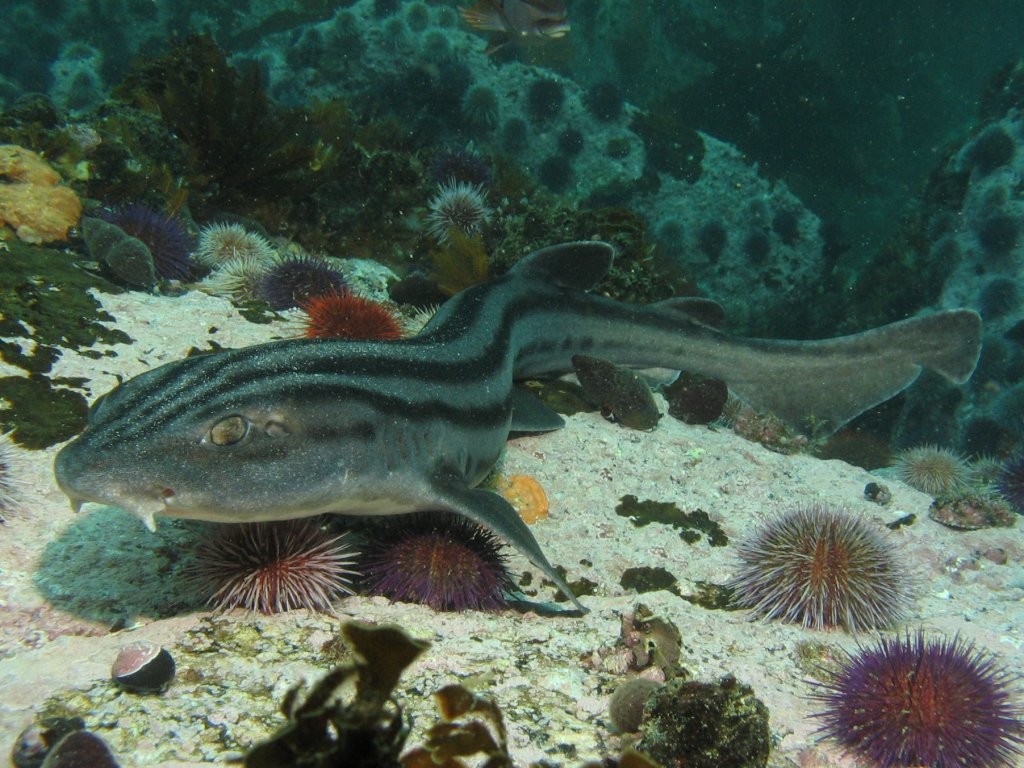Pyjama shark
A species of Barbeled cat sharks Scientific name : Poroderma africanum Genus : Barbeled cat sharks
Pyjama shark, A species of Barbeled cat sharks
Botanical name: Poroderma africanum
Genus: Barbeled cat sharks
Content
Description People often ask
 Photo By Guido Zsilavecz , used under CC-BY-SA-3.0 /Cropped and compressed from original
Photo By Guido Zsilavecz , used under CC-BY-SA-3.0 /Cropped and compressed from original Description
The pyjama shark is the larger and thicker-bodied of the two Poroderma species, growing to 1.1 m (3.6 ft) long and 7.9 kg (17 lb) or more in weight. Both sexes grow to roughly the same maximum size. The head and snout are short and slightly flattened, with a narrowly parabolic outline when viewed from above or below. Each nostril is split into tiny incurrent and excurrent openings by a flap of skin in front; the flap has a three-lobed shape with the central lobe forming a long, conical barbel. The barbels are thicker than in the leopard catshark, and do not reach the mouth. The eyes are horizontally oval and placed rather high on the head, with rudimentary nictitating membranes (protective third eyelids) and a thick ridge running underneath. The sizable mouth forms a broad arch, with short furrows extending from the corners onto both the upper and lower jaws; the upper teeth are exposed when the mouth is closed. There are 18–25 and 14–24 tooth rows on either side of the upper and lower jaws, respectively. The teeth have a slender central cusp flanked by a pair of small cusplets; those of adult males are slightly thicker than those of females. The body is fairly compressed from side to side and tapers towards the tail. The two dorsal fins are placed far back: the first originates over the rear of the pelvic fins while the second originates over the midpoint of the anal fin. The first dorsal is much larger than the second. The pectoral fins are large and broad. The pelvic fins are lower than the pectorals but their bases are about equal in length. Adult males have a pair of short, thick claspers, with the inner margins of the pelvic fins partially fused over them to form an "apron". The short and broad caudal fin has an indistinct lower lobe and a ventral notch near the tip of the upper lobe. The skin is very thick and bears well-calcified dermal denticles; each denticle has an arrowhead-shaped crown with three posterior points, mounted on a short stalk. The dorsal coloration is distinctive, consisting of 5–7 thick, parallel, dark stripes running from the snout to the caudal peduncle on a variably grayish or brownish background; the stripes become broken near the tail and the belly. In some sharks, the main stripe on either side may fork behind the eye, the stripes may be split in two by lighter central lines, or one or more large dark spots may be present. The underside is pale, sometimes with light gray spotting, and clearly demarcated from the flank color. Young sharks resemble the adults, but may be much lighter or have much darker stripes. An albino specimen has been recorded from False Bay.
* Disclaimer: The judgment on toxicity and danger is for reference only. We DO NOT GUARANTEE any accuracy of such judgment. Therefore, you SHALL NOT rely on such judgment. It is IMPORTANT TO SEEK PROFESSIONAL ADVICE in advance when necessary.
People often ask
What do pyjama shark eat?
How big does pyjama shark get?
Is pyjama shark social?
How does pyjama shark reproduce?
Scientific Classification
Phylum
Chordates Class
Sharks and rays Order
Ground sharks Family
Catsharks Genus
Barbeled cat sharks Species
Pyjama shark